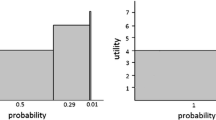Abstract
Expected-utility theory advances representation theorems that do not take the risk an act generates as a consequence of the act. However, a principle of expected-utility maximization that explains the rationality of preferences among acts must, for normative accuracy, take the act’s risk as a consequence of the act if the agent cares about the risk. I defend this conclusion against the charge that taking an act’s consequences to comprehend all the agent cares about trivializes the principle of expected-utility maximization.


Similar content being viewed by others
Notes
The evaluation of options gains still more efficiency by entertaining only consequences that options compared do not share.
I take events as event-tokens, rather than event-types, and so with features such as time and place.
Rabin (2000), however, maintains that the concavity of the agent’s utility curve is not a plausible expression of aversion to risk.
I follow Savage in addressing a version of Allais’s paradox that uses a partition of states and their probabilities, although the original paradox, as Mongin (2014) notes, uses just probabilities of outcomes.
Broome’s (1991, p. 103) principle of individuation by justifiers similarly limits individuation of consequences but does so objectively using the good and bad features of consequences rather than subjectively using an agent’s desires.
I thank Lara Buchak for pointing out this objection.
This is an application Theorem 2 of Krantz et al. (1971, p. 257).
I thank Philippe Mongin, participants at the 2016 LMU conference, “New Trends in Rational Choice Theory,” and two anonymous referees for helpful comments.
References
Allais M (1953) Le comportement de l’homme rationnel devant le risque: critique des postulats et axiomes de l’école Américaine. Econometrica 21:503–546
Allingham M (2002) Choice theory: a very short introduction. Oxford University Press, Oxford
Bernoulli D, (1954/1738) Exposition of a new theory on the measurement of risk. Econometrica 22:23–36
Binmore K (2009) Rational decisions. Princeton University Press, Princeton, NJ
Brigham E, Houston J (2009) Fundamentals of financial management, 12 edn. South-Western Cengage Learning, Mason
Broome J (1991) Weighing goods. Blackwell, Oxford
Buchak L (2013) Rationality and risk. Oxford University Press, Oxford
Dreier J (1996) Rational preference: decision theory as a theory of practical rationality. Theor Decis 40:249–276
Gibbard A, Harper W (1981/1978) Counterfactuals and two kinds of expected utility. In: Harper W, Stalnaker R, Pearce G (eds) Ifs: conditional, belief, decision, chance, and time. Reidel, Dordrecht, pp 153–190
Hacking I (2001) Probability and inductive logic. Cambridge University Press, Cambridge
Krantz D, Luce R, Suppes P, Tversky A. 1971. Foundations of measurement, vol 1. New York: Academic Press
Lewis D (1979) Attitudes De Dicto and De Se. Philos Rev 88:513–543
Machina M (1982) ‘Expected Utility’ analysis without the independence axiom. Econometrica 50:277–323
Mongin P (2014) Le paradoxe d'Allais: comment lui rendre sa signification perdue. Rev écon 65:743–779
Okasha S (2016) On the interpretation of decision theory. Econ Philos 32:409–433
Parfit D (1984) Reasons and persons. Oxford University Press, Oxford
Rabin M (2000) Risk aversion and expected-utility theory: a calibration theorem. Econometrica 68:1281–1292
Savage L, (1972/1954) The Foundations of Statistics, 2nd edn. Dover, New York
Stefánsson HO, Bradley R (2015) Philos Sci 82:602–625
Weirich P (2015) Models of decision-making: simplifying choices. Cambridge University Press, Cambridge
Author information
Authors and Affiliations
Corresponding author
Ethics declarations
Conflict of interest
The author declares that he has no conflict of interest.
Ethical Approval
This article does not contain any studies with human participants or animals performed by any of the authors.
Rights and permissions
About this article
Cite this article
Weirich, P. Risk as a Consequence. Topoi 39, 293–303 (2020). https://doi.org/10.1007/s11245-018-9570-4
Published:
Issue Date:
DOI: https://doi.org/10.1007/s11245-018-9570-4




